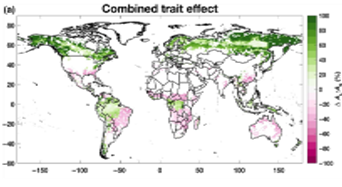The Science
Trees adjust their leaf area based on their traits and environmental conditions, which has enormous impacts on global carbon fluxes. We use first principles to predict leaf area adjustment in response to global change.
The Impact
We provide and test methods for improving carbon cycle predictions through advancing model predictions of leaf area. Tree‐level carbon allocation to leaves should be derived from first principles using mechanistic plant hydraulic processes in vegetation models.
Summary
Forest leaf area has enormous impacts on the carbon cycle because it mediates both forest productivity and resilience to climate extremes. Trees are capable of adjusting to changes in environment, yet many vegetation models use fixed carbon allocation schemes independent of environment, which introduces uncertainty in predictions. We develop an optimization‐based model in which tree carbon allocation to leaves is an emergent property of environment and plant traits. A combination of meta‐analysis, observational datasets, and model predictions find strong evidence that optimal hydraulic–carbon coupling explains observed patterns in leaf allocation.

Contacts (BER PM): Daniel Stover, SC-23.1, Daniel.Stover@science.doe.gov (301-903-0289)
PI Contact: Anna T. Trugman, School of Biological Sciences, University of Utah, a.trugman@utah.edu
Funding
USDA National Institute of Food and Agriculture, Grant/Award Number: 2018‐ 67012‐28020 and 2018‐67019‐27850; National Science Foundation, Grant/Award Number: 1714972 and 1802880; German Research Foundation, Grant/Award Number: RU 1657/2‐1, SCHM 2736/2‐1 and YA 274/1‐1 ; David and Lucille Packard Foundation; University of Utah Global Change and Sustainability Center; Next‐ Generation Ecosystem Experiments‐Tropics; Biological and Environmental Research; German Federal Ministry of Education and Research; Helmholtz Association.
Publications
A. Trugman, “Climate and plant trait strategies determine tree carbon allocation to leaves and mediate future forest productivity.” Global Change Biology 25, 3395 (2019). 10.1111/gcb.14680.